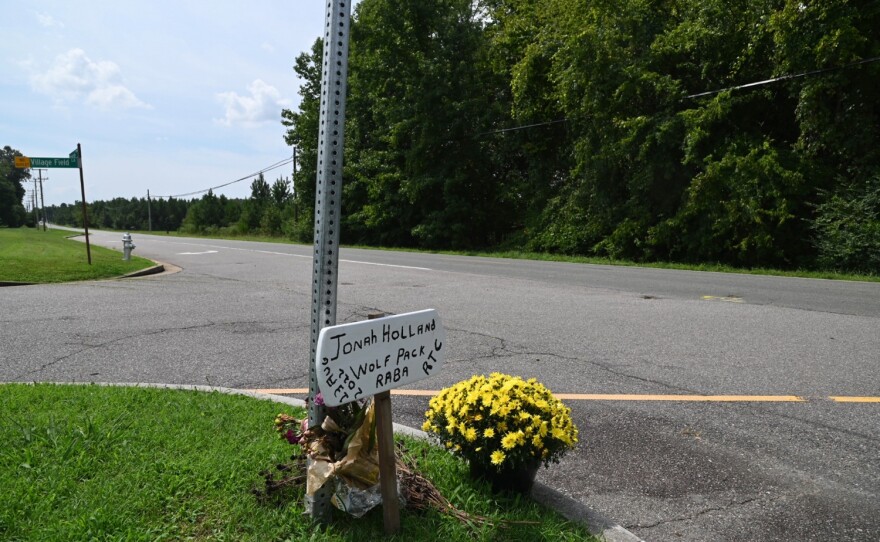In Henrico County’s Crump Park on a summer night, an organizer is offering a prayer. It’s for cyclist Jonah Holland, who died after a driver stuck her and Natalie Rainer with his SUV earlier this month. But she also prayed for some sort of purpose to come out of the loss.
“So that each person who's here will continue to live healthy with their families and come home from every ride,” the organizer said.
With that, hundreds of cyclists took off on a 21-mile memorial ride. Jeffrey Brooks, an 18-year-old, was reportedly intoxicated when he struck Holland and Rainer on Osborne Turnpike, on Aug. 13. He is due in court in November and faces multiple charges, including involuntary manslaughter.
The road runs parallel to the Capital Trail in the eastern portion of the county, offering an alternative route when pedestrian traffic on the trail presents issues for faster riders.
“The Capital Trail is a mixed-use trail. So, it's not just bicycles,” said Russ Starke, the president of the Richmond Area Bicycling Association. He said that often leaves cyclists with an uncomfortable question: “Do I ride on the road with the cars? I can't ride the speed that I'm trying to ride on the trail.”
In 2021, 16 cyclists were killed on Virginia’s roads and 502 were injured, 131 of whom were seriously injured, according to data from the Department of Motor Vehicles. But the number could be much higher.
University of Virginia professor Donna Chen was part of a research team that surveyed about 700 Virginia cyclists to better understand road safety. She said that a significant number of crashes involving cyclists were not reported, including 66% of minor injury crashes and 19% of severe injury crashes. Chen also found that crash reports’ focus on automobiles is one factor behind the underreporting of collisions involving bicycles.
Intentional design of our roadway system — and of individual routes and problem points — can help prevent deaths, according to experts. Chen said having dedicated bicycle infrastructure, where bikes are not traveling on mixed-usage roads, is the safest approach.
“It seems like, ‘Oh, it's common sense,’” Chen said. “If you have a dedicated bike lane — the greater the separation between the bike lane and the vehicle — the better it is for injury outcomes for the cyclists.”
Bryan Katz, a civil engineering professor at Virginia Tech, said making roads safer for cyclists is a multifaceted job.
“When we talk about the macro side, we really do look from a very systemic point of view to figure out how we improve safety by looking at [the] entire network,” Katz said. “Then when we get to the micro level, it's common in our field to figure out: ‘OK, let's pinpoint actual locations where we have safety issues.’”
Katz pointed out that not all types of countermeasures work in all locations, but the most effective ones work to reduce motorists’ speed.
“Whether it's warning signs, letting folks know that they need to share the road or using traffic-calming measures, such as roundabouts or chicanes, there’s lots of different measures that you can use to try to encourage drivers to slow down,” Katz said.
Chen referred to putting roads on a “diet.”
“These roads were designed to get the cars from the origin to destination as fast as possible … but now we realize we need to make the roads more context-appropriate for bicyclists and pedestrians,” she said. “If you design a road for 55 miles per hour, and then you say, ‘Oh, I want you to slow down,’ you just put a speed limit for 35 miles per hour. People don't really slow down … . [T]hat road was designed for a faster speed, and they feel it when they are driving it.”
She said when roads are narrowed, people intuitively pay more attention to what’s around them, including cyclists and pedestrians.
The area near this month’s fatal crash lacked all of the major design features that can make biking on that route safer. But Chen said even with those features, it can be difficult to make cyclists feel safe enough to increase their volume and reinforce to drivers that they are users of the same roads.
It presents what Chen calls a chicken and egg problem for road design and city planners.
“Unless you're in a major city in a dense metro area, there isn't enough bicyclists and pedestrians to drill into these drivers' heads that this is something I need to actively be watching for in my driving behavior,” Chen said.
In Henrico’s draft bike plan, most of Osborne Turnpike won’t be changed, including where August’s fatal accident took place. A parallel road is listed as a mixed-use road. Typically, these routes have “sharrows,” arrows painted on routes to indicate to drivers they are sharing the route with cyclists.
“That's a very low-cost improvement that can be implemented relatively quickly. But the reality is, depending on the volumes of bicyclists, that might not be an effective improvement for a long period of time, right?” Katz said.
Starke, the cycling association head, said ultimately, drivers must prioritize cyclists' safety.
“While talking about infrastructure is a great thing. I just can't overemphasize the importance of especially people operating motor vehicles to be alert and aware,” Starke said. “Because they may get a little dent in their car if they don't pay attention. But the cyclist is dead.”





